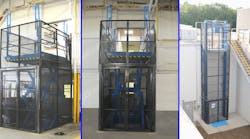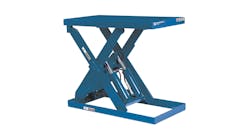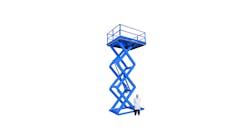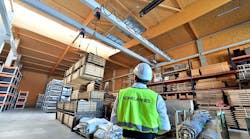Next time you're in a modern warehouse look up, or you might miss a lot of activity. The growth of e-commerce is influencing the design of many industrial facilities. Nowadays, it's not uncommon to see ceiling heights climbing to the 40-foot range to support modern conveyor systems and mezzanines for high-velocity order picking, according to an article in Material Handling & Logistics.
In addition, many manufacturers and distributors are continuing to build up instead of out to conserve space, says Michael Renken, vice president of sales at Advance Lifts Inc.
"A hot trend right now is mezzanine access," Renken says. "We see more and more space utilization in facilities with high ceilings. If someone has a high ceiling and they need more space, the cheapest way to do that is to build a mezzanine. But then you have to figure out how to get stuff onto the mezzanine.
Advance Lifts, a manufacturer of various lift solutions based in St. Charles, IL., has two primary products that help workers safely access mezzanines. This includes the company's recently introduced line of vertical reciprocating conveyors (VRCs) as well as its rider and non-rider scissor lifts and package lifts.
Here, we take a closer look at each style and how their different applications
VRCs Aim High
VRCs have few size limitations to the platform size or vertical travel distance. These are versatile units that can travel 100 feet and can accommodate small four-by-four platforms or large 10-by-12 platforms, Renken says.
These lifts are designed to move goods and materials between multiple floor levels quickly and safely. VRCs are typically the preferred unit for high-mezzanine access. The units may be floor or pit mounted.
All of the units conform to ASME B20.1 and VRC guidelines referenced in ASME B20.1. In addition, the motors are equipped with integral holding brakes, double chains, and carriages with mechanical locking brakes in the event of chain failure. The weight capacity for VRCs is 6,000+ pounds.
Scissor Lifts Eliminate Steps
Like VRCs, scissor lifts have a capacity of more than 6,000 pounds. But they come in both rider and non-rider styles. They typically come with larger platform sizes but have more limitations than VRCs, Renken says. For example, they only travel up to about 18 feet.
"They're good for single level only," Renken says. "But the scissor lift style is very appealing because you have the option to have a rider on it, so a worker doesn't have to run up and down stairs. There's less risk of injury when someone isn't running up and down stairs all of the time."
Scissor lifts typically are slightly more expensive than VRCs, and they have more limited applications, Renken says.
"In terms of what we're seeing in the field, it's really 50/50 between VRCs and scissor lifts," Renken says. "It depends on the application and what their needs are."
Package Lifts Move Small Parts Efficiently
Package lifts are smaller units that are typically loaded and unloaded by hand, and are designed to move smaller, lighter packages to or from mezzanine levels, Renken says.
They come in two models: the PAC-200, which has a max. platform size of 36-by-36 inches, and the PAC-500, which has a 42-by-42 inches max size. Both have a 200-pound capacity and travel 24 feet.
"This is ideal for moving something like a small box of parts, where someone will load a box of parts onto the lift, send it down, and then another material handling worker at the lower level picks it off and does what he needs to do with it," Renken explains.















